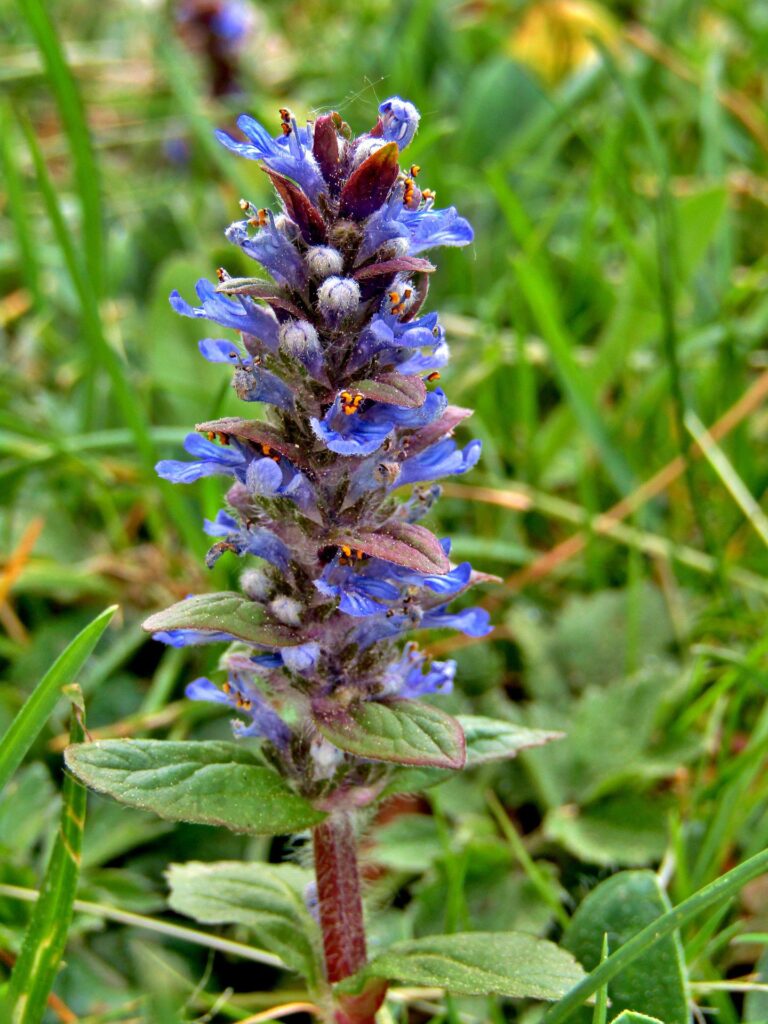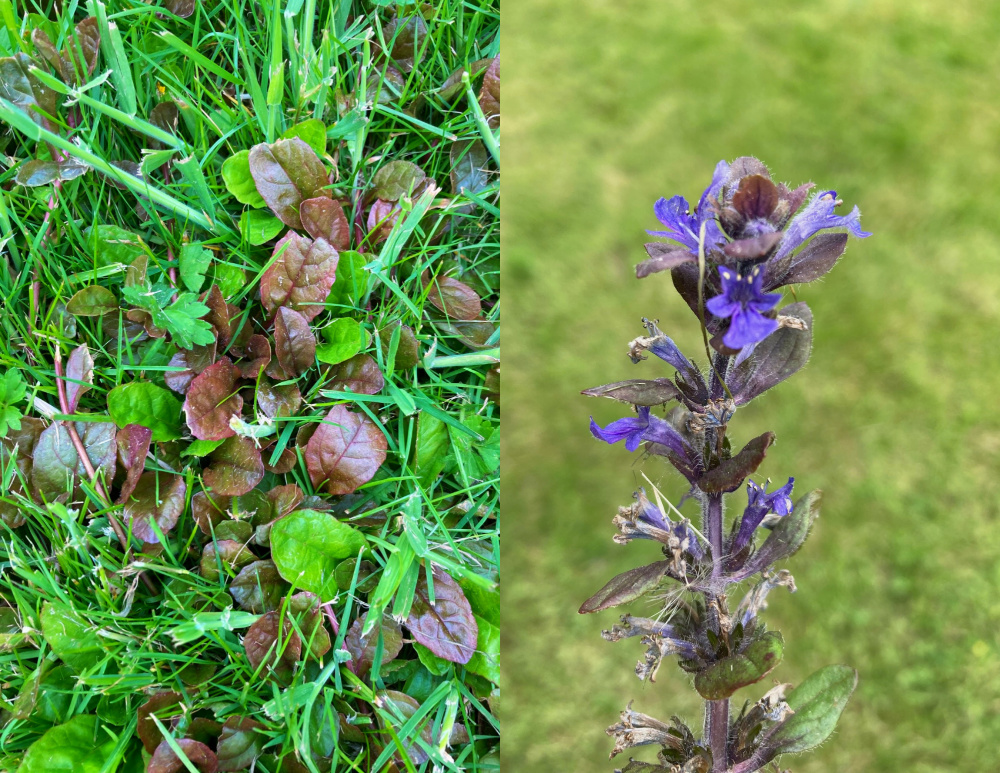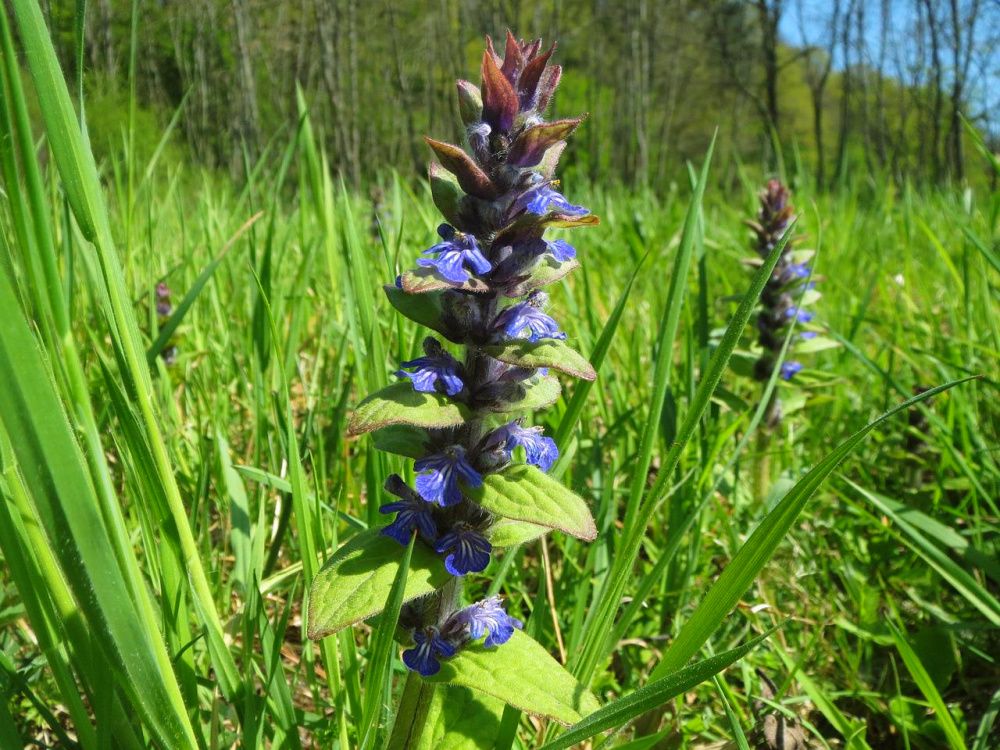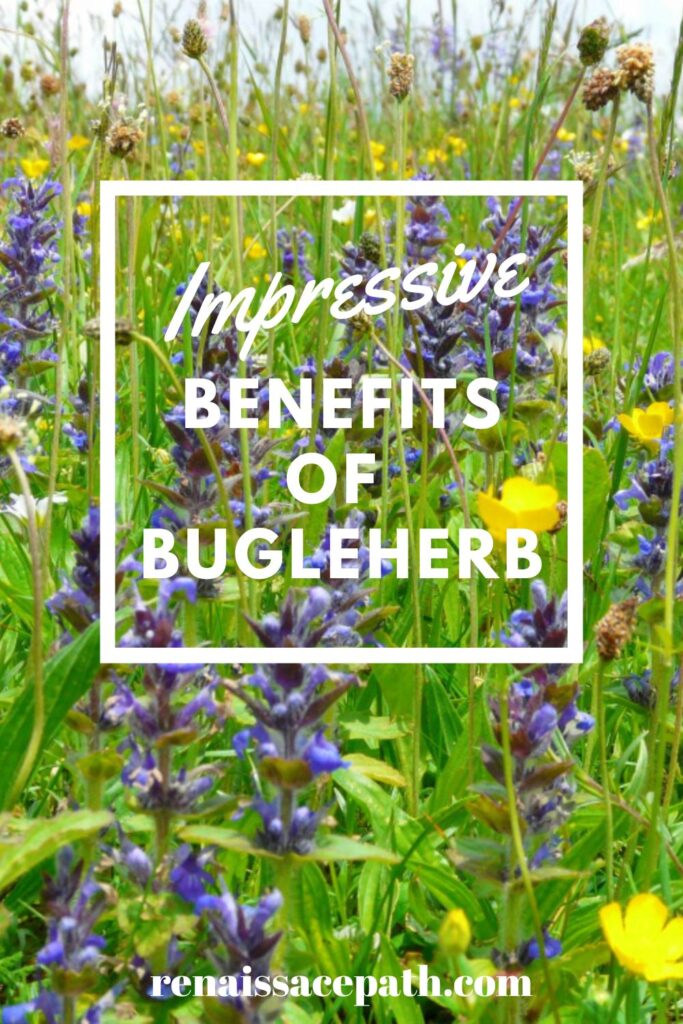Some of the links on this page contain affiliate links. Renaissance Path is a participant in the Amazon Associates Program, an affiliate advertising program that provides a way for websites to earn advertising fees by linking to products. We only link to products we normally use and trust. When you purchase an item through the link we receive a small commission at no additional cost to you. This helps pay for the costs associated with running this blog. Your support is greatly appreciated. Thank You!

Impressive Benefits of Bugleherb
Bugleherb(Ajuga reptans) is a herbaceous perennial flowering plant.
Ajuga is in the mint family Lamiaceae. It is native to southwestern Asia, northern Africa, and Europe.
It seems to prefer shade or partial shade, and moist soil although it can survive in drier soils. It is a great choice for ground cover.
Bugleherb is commonly known amongst herbalists and those in natural medicine as a herb that is used for hyperthyroidism(excess thyroid hormone). Throughout history, it’s been used for ailments relating to the heart, respiratory health, menstrual cramps, and many other things.

Identification
Bugleherb(Ajuga reptans) is 4 to 14 inches tall and has blueish purple flowers. It is in the mint family and has the signature square stem, two sides of the stem are smooth the other two sides are hairy.
It is a rosette-forming ground cover. The plant sends out shoots similar to strawberries to spread. It spreads pretty aggressively like others in the mint family. It flowers in late spring to early summer. It seems to prefer shady areas. It is an evergreen perennial and has lovely green/purple foliage.
Whorls of 4 blueish-purple to white flowers arranged in terminal spikes, each with dark veins on the lower lip. The leaves are purplish-green growing up the stem in opposite pairs.
Other names know by
Common Bugleherb
Gypsywort
Ajuga
Carpet Bugle
Blue Bugle
Carpetweed
Carpenter’s herb
Creeping Gunsel
Bugleweed
Habitat
Ajuga Reptans(Bugleherb) originates from Asia, Europe, and Northern Africa. Bugleherb was brought to North America by colonists.
The plant does well in partial shade although it can handle full sun once the plant is fully established. It grows in damp woods, along the side of mountains, and in gardens. It seems to prefer damp or marshy soil. It is a popular choice for flower beds, most people like to plant it as ground cover under ornamental trees or bushes or to use as a border. It can creep into your lawn so just be aware.

Bugleherb Medicinal Uses and Benefits
The Ajuga species has been used in Romanian Folk Medicine for years due to its anthelmintic, astringent, febrifuge, diuretic, anti-fungal, anti-inflammatory, antimicrobial, and antioxidant properties. It was used to treat fevers, pain, arthritis, dysentery, malaria, hypertension, diabetes, and gastrointestinal disorders.
You can use dried aerial parts of bugleherb to make a healing salve to use on cuts or scrapes, even on fungal infections. Ajuga showed anti-fungal activity in this study here against 5 strains of fungi including, Aspergillus flavus, Aspergillus niger, Candida parapsilosis, Candida albicans, and Penicillium fumiculosum.
Tea has been one of the most common ways bugleherb has been used historically. It is said to have great pain-relieving properties even as effective as the drug Diclofenac which is a non-steroidal anti-inflammatory. It can help sore throats, and expel excess mucus.
Herbalists have used bugleherb for hyperthyroid for a long time because it reduces the hormone that causes hyperthyroid, it also reduces racing heart associated with hyperthyroidism.
It has been shown to be a mild laxative.
Bugleherb Studies
Ajuga Reptans(bugleherb)was found to have strong anti-inflammatory actions and in a study it was shown to lower white blood cell count(WBC) significantly. Ajuga reptans ethanol extract decreased phagocytosis, oxidative stress, PMN(polymorphonuclear), and total leukocytes. The Ajuga reptans 25 mg dw/mL and 100 mg dw/mL extracts showed antioxidant and anti-inflammatory activity, comparable with diclofenac(1). The study was in vivo.
In herbal medicine, A. reptans L. has been used as an anti-diabetic,
anti-hypertensive, diuretic, and hepatoprotective medicinal plant. Several phytochemicals have been identified in A. reptans, such as anthocyanidin glycosides, ecdysteroids, phenylpropanoid glycoside, neo-clerodane diterpenes, and iridoids that possess antioxidant, antimicrobial, and anti-inflammatory activity(2).
Teupolioside, a phenylpropanoid glycoside of Ajuga reptans was shown to reduce pro-inflammatory cytokines in rats who had colitis. The study suggested the administration of Teupolioside may be beneficial in treating inflammatory bowel disease in humans(3).

Warnings
There is another plant called Bugleweed with the latin name Lycopus virginicus, the bugleherb/bugleweed we are talking about in this blog post is Ajuga Reptans aka Bugleherb/bugleweed or Common Bugle/Carpet Bugleweed. It is easy to get them mixed up when researching this beautiful ground cover.
This plant should not be used if you have hypothyroidism. Always check with your doctor first before starting any herb or supplement.
It is not recommended during pregnancy or breastfeeding. Also, it can have anti-diabetic activity therefore it is recommended to be careful if you are diabetic.
Final thoughts
Bugleherb is an amazing ground cover but it also has medicinal value. I have some in my garden. It is super low maintenance and what I love about it is it seems to choke out other weeds, and the bees seem to love this plant as well.
Do you have bugleherb in your garden? Let me know in the comments.
Much Love,
Melissa
If you enjoy reading about natural healing herbs check out my post on Gypsyweed.
This website is for educational purposes only. The information provided by Renaissance Path is not intended to diagnose, treat, or cure any diseases. Please consult a qualified health care professional for medical advice.
Whoa, I’m fairly knowledgeable about herbs, but I don’t know that I’ve even heard of this one before! I’m going to do a little digging to see if it grows wild here in Nebraska. Thanks for the informative post!
I bet it grows there. If not it is usually in the nurseries. It’s a lovely ground cover. My bugleweed is growing on my front lawn and has now moved to the front flower beds.
I’ve never even heard of this herb. Great info. Thank you
Thank you for your post Melisa. Does Ajuga Reptans grow on the hills of Colorado?
Hi! I’m planning on using bungle in a salve for pain relief and skin ailments. I’m also hypothyroid. I understand ingestion would be a bad idea. Do you think it would be a problem applied topically?
Thanks for the great info!
Hello! I have this bugleweed plant in my backyard. I have severe Eczema on my face and scalp and would love to try making a cream and oil based lotion for my scalp. Please let me know how to make it into a tea and cream and or how to infuse it into coconut oil. Please Please Please! I hate having eczema on my face, I cannot wear foundation on my eczema sores on my face. So I do not wear makeup anymore and I LOVE wearing it. Please Help! Thank You! Sincerely! Kelly D.